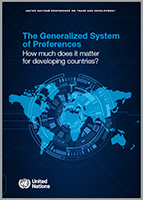
The Generalized System of Preferences (GSP) scheme is a voluntary trade measure implemented by developed countries that provide an advantageous, or “preferential”, tariff treatment to imports from developing countries.
Different national GSP schemes were introduced following a resolution adopted at the second session of the United Nations Conference on Trade and Development (UNCTAD) in 1968.
The scheme is expected to contribute to developing countries’ export growth particularly in the manufacturing sector.
Five decades since its inception, the GSP stands at a crossroads. The effectiveness of tariff incentives as a tool to foster exports has eroded over time as trade liberalization processes proceed at multilateral, regional and unilateral levels, and as the relevance of tariffs to overall trade costs declines.
The question arises as to whether the relevance and effectiveness of tariff preferences remain valid today.
Focusing on the GSP schemes of the Quad economies (Canada, European Union, Japan, and the United States of America), which accounted for about 50 per cent of global imports on average in the period between 2004 and 2018, the study provides an objective assessment of tariff advantages offered under the GSP by quantifying the economic “value” of preferential treatment and the obstacles to the realization of its full potential.
The following points emerged from the study:
- The preferential tariff rates offered under the Quad GSP schemes have generated tariff savings for importers, particularly for those who import products from least developed countries (LDCs).
- The GSP preferences applicable to imports from non-LDC developing countries, however, are becoming negligible.
- By contrast, we observe a significant value and improvement in tariff advantages that LDCs receive from the Quad economies under their respective GSP-for-LDCs schemes.
- The benefits from GSP-for-LDCs preferences are however highly concentrated in a few countries and products.
- A significant preference margin provides an incentive to importers to apply for the GSP preferences, according to the Quad import data under GSP-for-LDCs schemes.




